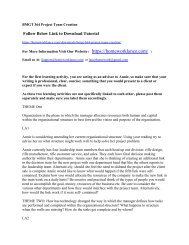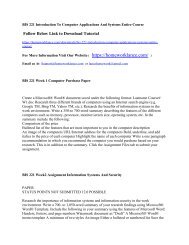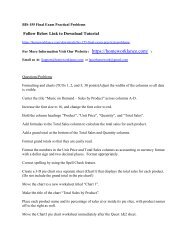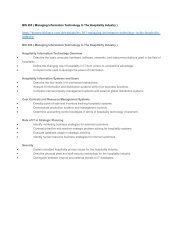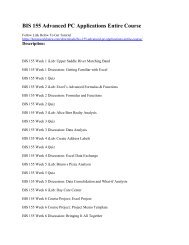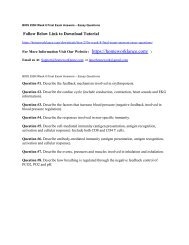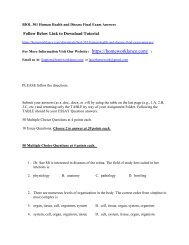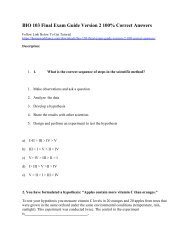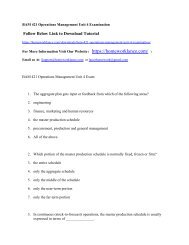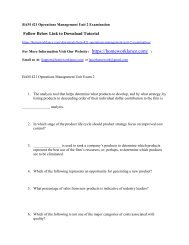BAM 421 Operations Management Unit 3 Examination
BAM 421 Operations Management Unit 3 Examination
BAM 421 Operations Management Unit 3 Examination
You also want an ePaper? Increase the reach of your titles
YUMPU automatically turns print PDFs into web optimized ePapers that Google loves.
<strong>BAM</strong> <strong>421</strong> <strong>Operations</strong> <strong>Management</strong> <strong>Unit</strong> 3 <strong>Examination</strong><br />
Follow Below Link to Download Tutorial<br />
https://homeworklance.com/downloads/bam-<strong>421</strong>-operations-management-unit-3-examination/<br />
For More Information Visit Our Website ( https://homeworklance.com/ )<br />
Email us At: Support@homeworklance.com or lancehomework@gmail.com<br />
<strong>BAM</strong> <strong>421</strong> <strong>Operations</strong> <strong>Management</strong> <strong>Unit</strong> 3 Exam<br />
1. The behavioral approach to job design that involves giving the worker a larger portion of<br />
the total task is job _______________.<br />
2. enlargement<br />
3. enrichment<br />
4. enhancement<br />
5. rotation<br />
6. involvement<br />
2. When a worker has a say in the work methods that he/she wishes to utilize, his/her job is<br />
characterized by _______________.<br />
3. skill variety<br />
4. job identity<br />
5. job significance<br />
6. feedback<br />
7. autonomy
3. Which of the following terms implies an increase in responsibility and control in the<br />
vertical direction?<br />
4. job rotation<br />
5. job enrichment<br />
6. job re-design<br />
7. job enlargement<br />
8. job satisfaction<br />
4. Which of the following statements describes job rotation?<br />
5. The job contains a larger number of similar tasks.<br />
6. The job includes some planning and control necessary for job accomplishment.<br />
7. The operator works on different shifts on a regular basis.<br />
8. The operator’s schedule is flexible.<br />
9. The operator is allowed to move, for example, from one type of CNC machine to the<br />
other.<br />
5. The difference between job enrichment and job enlargement is that ______________.<br />
6. enlarged jobs involve vertical expansion while enriched jobs involve horizontal<br />
expansion<br />
7. enriched jobs enable an employee to do a number of boring jobs instead of just one<br />
8. job enlargement is more psychologically satisfying than job enrichment<br />
9. job enrichment is suitable for all employees, whereas job enlargement is not<br />
10. enriched jobs involve vertical expansion while enlarged jobs involve horizontal<br />
expansion
6. Suppose that the allowance factor for a job is 0.10 and the normal time is 5 hours. What<br />
is the standard time?<br />
7. 4.5 hours<br />
8. 4.9 hours<br />
9. 5.1 hours<br />
10. 5.6 hours<br />
11. 50.0 hours<br />
12. A job characterized by _______________ allows a worker to use his/her dexterity,<br />
physical strength and skills to do his/her work.<br />
13. feedback<br />
14. skill variety<br />
15. job identity<br />
16. job significance<br />
17. autonomy<br />
8. Outsourcing ______________.<br />
9. transfers traditional internal activities to outside vendors<br />
10. utilizes the efficiency which comes with specialization<br />
11. lets the outsourcing firm focus on its key success factors<br />
12. None of the above are true of outsourcing.<br />
13. All of the above are true of outsourcing.<br />
9. The transfer of some of what are traditional internal activities and resources of a firm to<br />
outside vendors is ______________.<br />
10. a standard use of the make or buy decision
11. not allowed by the ethics code of the Supply <strong>Management</strong> Institute<br />
12. offshoring<br />
13. outsourcing<br />
14. keiretsu<br />
10. The Institute for Supply <strong>Management</strong> ________________.<br />
11. establishes laws and regulations for supply management<br />
12. is an agency of the <strong>Unit</strong>ed Nations charged with promoting ethical conduct globally<br />
13. publishes the principles and standards for ethical supply management conduct<br />
14. prohibits backward integration into developing economies<br />
15. All of the above are true.<br />
11. In supply-chain management, ethical issues ______________.<br />
12. are particularly important because of the enormous opportunities for abuse<br />
13. may be guided by company rules and codes of conduct<br />
14. become more complex the more global the supply chain<br />
15. may be guided by the principles and standards of the Institute for Supply <strong>Management</strong><br />
16. All of the above are true.<br />
12. Which one of the following is not a supply-chain strategy?<br />
13. negotiation with many suppliers<br />
14. vertical integration<br />
15. keiretsu
16. short-term relationships with few suppliers<br />
17. virtual companies<br />
13. A disadvantage of the “few suppliers” strategy is _______________.<br />
14. the risk of not being ready for technological change<br />
15. the lack of cost savings for customers and suppliers<br />
16. possible violations of the Sherman Antitrust Act<br />
17. the high cost of changing partners<br />
18. All of the above are disadvantages of the “few suppliers” strategy.<br />
14. In the basic EOQ model, if the cost of placing an order doubles, and all other values<br />
remain constant, the EOQ will _______________.<br />
15. increase by about 41%<br />
16. increase by 100%<br />
17. increase by 200%<br />
18. increase, but more data is needed to say by how much<br />
19. either increase or decrease<br />
15. In the basic EOQ model, if D=6000 per year, S=$100 andH=$5 per unit per month, then<br />
the economic order quantity is approximately _______________.<br />
16. 24<br />
17. 100<br />
18. 141
19. 490<br />
20. 600<br />
16. The two most basic inventory questions answered by the typical inventory model are<br />
_______________.<br />
17. timing and cost of orders<br />
18. quantity and cost of orders<br />
19. timing and quantity of orders<br />
20. order quantity and service level<br />
21. ordering cost and carrying cost<br />
17. Among the advantages of cycle counting is that it ______________.<br />
18. makes the annual physical inventory more acceptable to management<br />
19. does not require the detailed records necessary when annual physical inventory is used<br />
20. does not require highly trained people<br />
21. allows more rapid identification of errors and consequent remedial action than is possible<br />
with annual physical inventory<br />
22. does not need to be performed for less expensive items<br />
18. Which of the following is an element of inventory holding costs?<br />
19. housing costs<br />
20. material handling costs<br />
21. investment costs<br />
22. pilferage, scrap and obsolescence
23. All of the above are elements of inventory holding cost.<br />
19. Most inventory models attempt to minimize _______________.<br />
20. the likelihood of a stockout<br />
21. the number of items ordered<br />
22. total inventory based costs<br />
23. the number of orders placed<br />
24. the safety stock<br />
20. Top executives tend to focus their attention on which type of forecasts?<br />
21. short-range<br />
22. medium-range<br />
23. long-range<br />
24. weather<br />
25. the forecast for the next day’s absentee levels<br />
21. Which of the following would most likely fall under the scope of only an operations<br />
manager?<br />
22. research and development<br />
23. new product plans<br />
24. capital investments<br />
25. facility location and expansion<br />
26. setting inventory levels
22. Disaggregation _______________.<br />
23. breaks the aggregate plan into greater detail<br />
24. transforms the master production schedule into an aggregate plan<br />
25. calculates the optimal price points for yield management<br />
26. converts product schedules and labor assignments to a facility-wide plan<br />
27. is an assumption required for the use of the transportation model in aggregate planning<br />
23. Aggregate planning would entail which of the following production aspects at BMW for<br />
a 12 month period?<br />
24. number of cars with a hi-fi stereo system to produce<br />
25. number of two-door vs. four-door cars to produce<br />
26. number of green cars to produce<br />
27. total number of cars to produce<br />
28. b, c, and d are correct.<br />
24. What directly results from disaggregation of an aggregate plan?<br />
25. a master production schedule<br />
26. priority scheduling<br />
27. a transportation matrix<br />
28. a capacity-demand matrix<br />
29. detailed work schedules
25. Dependence on an external source of supply is found in which of the following aggregate<br />
planning strategies?<br />
26. varying production rates through overtime or idle time<br />
27. subcontracting<br />
28. using part-time workers<br />
29. back-ordering during high demand periods<br />
30. hiring and laying off



